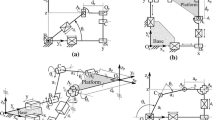Abstract
This paper presents a synthesis methodology for robots that have less than six degrees of freedom, termed constrained robots. The goal is to determine the physical parameters of the chain that fit its workspace to a given set of spatial positions. Our formulation uses the dual quaternion form of the kinematics equations of the constrained robot. Here we develop the theory and formulate the synthesis equations for the spatial RPR robot. Their solution ensures that the three dimensional workspace of this robot contains a given set of four spatial positions.
Access this chapter
Tax calculation will be finalised at checkout
Purchases are for personal use only
Preview
Unable to display preview. Download preview PDF.
Similar content being viewed by others
References
Angeles, J., 1998, “The application on dual algebra to kinematic analysis,” Computational Methods in Mechanical Systems, NATO ASI Series (ed. J. Angeles and E. Zakhariev) Springer, Berlin.
Bottema, O., and Roth, B., 1979, Theoretical Kinematics, North Holland. (reprinted Dover Publications 1990 ).
Chedmail, P., 1998, “Optimization in Multi-DOF Mechanisms,” Computational Methods in Mechanical Systems, NATO ASI Series (ed. J. Angeles and E. Zakhariev) Springer, Berlin.
Chen, P., and Roth, B., 1969, Design Equations for the Finitely and Infinitesimally Separated Position Synthesis of Binary Links and Combined Link Chains, ASME J. Eng. Ind. 91(1): 209219.
Cox, D., Little, J. and O’Shea, D., 1998, Using Algebraic Geometry, Springer, New York.
Craig, J., 1986, Introduction to Robotics,Addison-Wesley.
Gosselin, C. M., 1998, “On the design of efficient parallel mechanisms,” Computational Methods in Mechanical Systems, NATO ASI Series (ed. J. Angeles and E. Zakhariev) Springer, Berlin.
Gupta, K.C., 1986, “Kinematic Analysis of Manipulators Using Zero Reference Position Description”, Int. J. Robot. Res., 5 (2): 5–13
Huang, C., and Chang, Y.-J., 2000, “Polynomial Solution to the Five-Position Synthesis of Spatial CC Dyads via Dialytic Elimination,” Proceedings of the ASME Design Technical Conferences, September 1013, 2000, Baltimore MD, Paper Number DETC2000/MECH-14102.
Innocenti, C., 1994, “Polynomial Solution of the Spatial Burmester Problem.” Mechanism Synthesis and Analysis, ASME DE vol. 70.
Kumar, A., and Waldron, K. J., 1981, “The Workspaces of a Mechanical Manipulator,” ASME Journal of Mechanical Design, vol. 103, pp 665–672.
Larochelle, P., 2000, “Approximate motion synthesis via parametric constraint manifold fitting,” Advances in Robot Kinematics (eds. J. Lenarcic and M. M. Stanisic) Kluwer Acad. Publ., Dordrecht.
Mavroidis, C., Lee, E. and Alan, M. 2001, “A New Polynomial Solution to the Geometric Design Problem of Spatial R-R Robot Manipulators Using the Denavit and Hartenberg Parameters,” ASME J. of Mechanical Design 123 (2): 58–67.
Lee, E., and Mavrodis, D., 2002 (in press), “Solving the Geometric Design Problem of Spatial 3R Robot Manipulators Using Polynomial Homotopy Continuation,” ASME J. of Mechanical Design.
Liao, Q. and McCarthy, J.M., 1998, “On the seven position synthesis of a 5-SS platform linkage”, ASME Journal of Mechanical Design.
McCarthy, J. M., 1990, An Introduction to Theoretical Kinematics,MIT Press.
McCarthy, J. M., 2000a, Geometric Design of Linkages, Springer, New York.
McCarthy, J. M., 2000b, “Mechanisms Synthesis Theory and the Design of Robots,” Proceedings of the 2000 IEEE International Conference on Robotics and Automation, April 2428 2000, San Francisco, CA.
Perez, A., and McCarthy, J. M., 2000, “Dimensional Synthesis of Spatial RR Robots,” Advances in Robot Kinematics, Lenarcic, J., ed., Piran-Portoroz, Slovenia, June 2630, 2000.
Suh, C.H. and Radclie, C.W.,1978, Kinematics and mechanisms design. John Wiley Sons, 1978.
Tsai, L.W., 1999, Robot Analysis. John Wiley and Sons, New York.
Tsai, L.W. and Roth, B., 1973, “A Note on the Design of Revolute-Revolute Cranks” Mechanisms and Machine Theory, Vol. 8, pp 23–31.
Yang, A.T., and Freudenstein, F., 1964, “Application of Dual-Number Quaternion Algebra to the Analysis of Spatial Mechanisms”, ASME Journal of Applied Mechanics, June 1964, pp. 300–308.
Author information
Authors and Affiliations
Editor information
Editors and Affiliations
Rights and permissions
Copyright information
© 2002 Springer Science+Business Media Dordrecht
About this chapter
Cite this chapter
Perez, A., McCarthy, J.M., Bennett, B. (2002). Dual Quaternion Synthesis of Constrained Robots. In: Lenarčič, J., Thomas, F. (eds) Advances in Robot Kinematics. Springer, Dordrecht. https://doi.org/10.1007/978-94-017-0657-5_47
Download citation
DOI: https://doi.org/10.1007/978-94-017-0657-5_47
Publisher Name: Springer, Dordrecht
Print ISBN: 978-90-481-6054-9
Online ISBN: 978-94-017-0657-5
eBook Packages: Springer Book Archive




